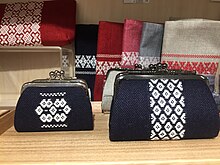
Kogin-zashi (こぎん刺し) is one of the techniques of sashiko, or traditional Japanese decorative reinforcement stitching, that originated in the part of present-day Aomori Prefecture controlled by the Tsugaru clan during the Edo period (1603-1867). It is also referred to as sashi-kogin.
Kogin-zashi is generally constructed of white cotton embroidery in diamond patterns on indigo-dyed fabrics such as cotton, linen and hemp. During the Edo period, peasants were not permitted to wear cotton cloth in the Tsugaru region, so cotton thread was added to linen cloth with the aim of bypassing these regulations and making clothes warmer and more protective during the harsh winter weather, as well as strengthening the cloth.
